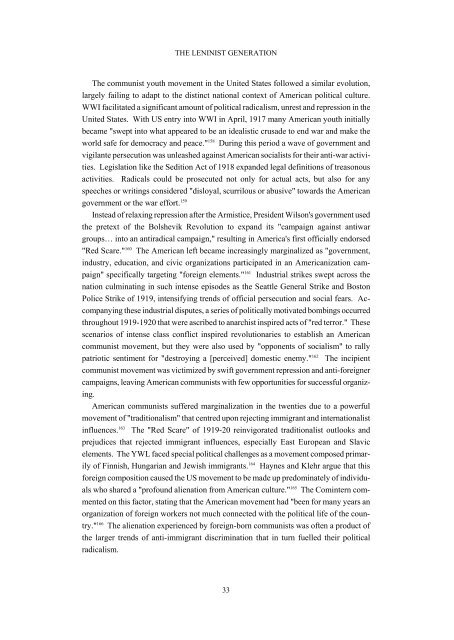Joel A Lewis Youth Against Fascism.pdf
Joel A Lewis Youth Against Fascism.pdf
Joel A Lewis Youth Against Fascism.pdf
You also want an ePaper? Increase the reach of your titles
YUMPU automatically turns print PDFs into web optimized ePapers that Google loves.
THE LENINIST GENERATION<br />
The communist youth movement in the United States followed a similar evolution,<br />
largely failing to adapt to the distinct national context of American political culture.<br />
WWI facilitated a significant amount of political radicalism, unrest and repression in the<br />
United States. With US entry into WWI in April, 1917 many American youth initially<br />
became "swept into what appeared to be an idealistic crusade to end war and make the<br />
world safe for democracy and peace." 158 During this period a wave of government and<br />
vigilante persecution was unleashed against American socialists for their anti-war activities.<br />
Legislation like the Sedition Act of 1918 expanded legal definitions of treasonous<br />
activities. Radicals could be prosecuted not only for actual acts, but also for any<br />
speeches or writings considered "disloyal, scurrilous or abusive" towards the American<br />
government or the war effort. 159<br />
Instead of relaxing repression after the Armistice, President Wilson's government used<br />
the pretext of the Bolshevik Revolution to expand its "campaign against antiwar<br />
groups… into an antiradical campaign," resulting in America's first officially endorsed<br />
"Red Scare." 160 The American left became increasingly marginalized as "government,<br />
industry, education, and civic organizations participated in an Americanization campaign"<br />
specifically targeting "foreign elements." 161 Industrial strikes swept across the<br />
nation culminating in such intense episodes as the Seattle General Strike and Boston<br />
Police Strike of 1919, intensifying trends of official persecution and social fears. Accompanying<br />
these industrial disputes, a series of politically motivated bombings occurred<br />
throughout 1919-1920 that were ascribed to anarchist inspired acts of "red terror." These<br />
scenarios of intense class conflict inspired revolutionaries to establish an American<br />
communist movement, but they were also used by "opponents of socialism" to rally<br />
patriotic sentiment for "destroying a [perceived] domestic enemy." 162 The incipient<br />
communist movement was victimized by swift government repression and anti-foreigner<br />
campaigns, leaving American communists with few opportunities for successful organizing.<br />
American communists suffered marginalization in the twenties due to a powerful<br />
movement of "traditionalism" that centred upon rejecting immigrant and internationalist<br />
influences. 163 The "Red Scare" of 1919-20 reinvigorated traditionalist outlooks and<br />
prejudices that rejected immigrant influences, especially East European and Slavic<br />
elements. The YWL faced special political challenges as a movement composed primarily<br />
of Finnish, Hungarian and Jewish immigrants. 164 Haynes and Klehr argue that this<br />
foreign composition caused the US movement to be made up predominately of individuals<br />
who shared a "profound alienation from American culture." 165 The Comintern commented<br />
on this factor, stating that the American movement had "been for many years an<br />
organization of foreign workers not much connected with the political life of the country."<br />
166 The alienation experienced by foreign-born communists was often a product of<br />
the larger trends of anti-immigrant discrimination that in turn fuelled their political<br />
radicalism.<br />
33

















